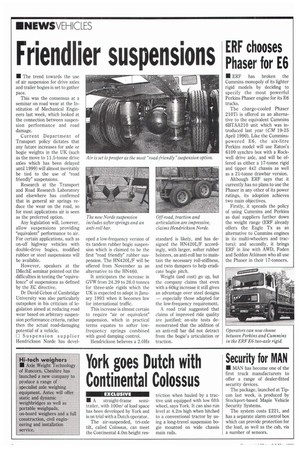Friendlier suspensions
Page 10

If you've noticed an error in this article please click here to report it so we can fix it.
• The trend towards the use of air suspension for drive axles and trailer bogies is set to gather pace.
This was the consensus at a seminar on road wear at the Institution of Mechanical Engineers last week, which looked at the connection between suspension performance and road damage.
Current Department of Transport policy dictates that any future increases for axle or bogie weights in the UK (such as the move to 11.5-tonne drive axles which has been delayed until 1999) will almost inevitably be tied to the use of "road friendly" suspensions.
Research at the Transport and Road Research Laboratory and elsewhere has confirmed that in general air springs reduce the wear on the road, so for most applications air is seen as the preferred option.
Any legislation will, however, allow suspensions providing "equivalent" performance to air. For certain applications, such as on-off highway vehicles with double-drive bogies, modified rubber or steel suspensions will be available.
However, speakers at the IMechE seminar pointed out the difficulties in testing the "equivalence" of suspensions as defined by the EC directive.
Dr David Cebon of Cambridge University was also particularly outspoken in his criticism of legislation aimed at reducing road wear based on arbitrary suspension performance criteria, rather then the actual road-damaging potential of a vehicle.
U Suspension supplier Hendrickson Norde has devel oped a low-frequency version of its tandem rubber bogie suspension which is claimed to be the first "road friendly" rubber suspension. The HN420L/F will be offered from November as an alternative to the HN460.
It anticipates the increase in GVW from 24.39 to 26.0 tonnes for three-axle rigids which the UK is expected to adopt in January 1993 when it becomes law for international traffic.
This increase is almost certain to require "air or equivalent" suspension, which in practical terms equates to softer lowfrequency springs combined with good damping control.
Hendrickson believes a 2.0Hz standard is likely, and has designed the HN420L/F accordingly, with larger, softer rubber bolsters, an anti-roll bar to maintain the necessary roll-stiffness, and twin dampers to help eradicate bogie pitch.
Weight (and cost) go up, but the company claims that even with a 60kg increase it still gives an advantage over steel designs — especially those adapted for the low-frequency requirement.
A road trial suggested that claims of improved ride quality are justified; on-site tests demonstrated that the addition of an anti-roll bar did not detract from the bogie's articulation or traction.




















































































